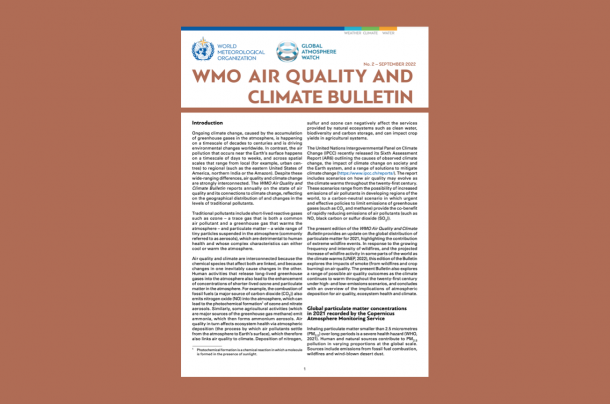Ongoing climate change, caused by the accumulation of greenhouse gases in the atmosphere, is happening on a timescale of decades to centuries and is driving environmental changes worldwide. In contrast, the air pollution that occurs near the Earth’s surface happens on a timescale of days to weeks, and across spatial scales that range from local (for example, urban centres) to regional (such as the eastern United States of America, northern India or the Amazon). Despite these wide‑ranging differences, air quality and climate change are strongly interconnected. The WMO Air Quality and Climate Bulletin reports annually on the state of air quality and its connections to climate change, reflecting on the geographical distribution of and changes in the levels of traditional pollutants.
Traditional pollutants include short‑lived reactive gases such as ozone – a trace gas that is both a common air pollutant and a greenhouse gas that warms the atmosphere – and particulate matter – a wide range of tiny particles suspended in the atmosphere (commonly referred to as aerosols), which are detrimental to human health and whose complex characteristics can either cool or warm the atmosphere.
Air quality and climate are interconnected because the chemical species that affect both are linked, and because changes in one inevitably cause changes in the other. Human activities that release long‑lived greenhouse gases into the atmosphere also lead to the enhancement of concentrations of shorter‑lived ozone and particulate matter in the atmosphere. For example, the combustion of fossil fuels (a major source of carbon dioxide (CO2)) also emits nitrogen oxide (NO) into the atmosphere, which can lead to the photochemical formation1 of ozone and nitrate aerosols. Similarly, some agricultural activities (which are major sources of the greenhouse gas methane) emit ammonia, which then forms ammonium aerosols. Air quality in turn affects ecosystem health via atmospheric deposition (the process by which air pollutants settle from the atmosphere to Earth’s surface), which therefore also links air quality to climate. Deposition of nitrogen, sulfur and ozone can negatively affect the services provided by natural ecosystems such as clean water, biodiversity and carbon storage, and can impact crop yields in agricultural systems.
The United Nations Intergovernmental Panel on Climate Change (IPCC) recently released its Sixth Assessment Report (AR6) outlining the causes of observed climate change, the impact of climate change on society and the Earth system, and a range of solutions to mitigate climate change. The report includes scenarios on how air quality may evolve as the climate warms throughout the twenty‑first century. These scenarios range from the possibility of increased emissions of air pollutants in developing regions of the world, to a carbon‑neutral scenario in which urgent and effective policies to limit emissions of greenhouse gases (such as CO2 and methane) provide the co‑benefit of rapidly reducing emissions of air pollutants (such as NO, black carbon or sulfur dioxide (SO2)).
The present edition of the WMO Air Quality and Climate Bulletin provides an update on the global distribution of particulate matter for 2021, highlighting the contribution of extreme wildfire events. In response to the growing frequency and intensity of wildfires, and the projected increase of wildfire activity in some parts of the world as the climate warms (UNEP, 2022), this edition of the Bulletin explores the impacts of smoke (from wildfires and crop burning) on air quality. The present Bulletin also explores a range of possible air quality outcomes as the climate continues to warm throughout the twenty‑first century under high‑ and low‑emissions scenarios, and concludes with an overview of the implications of atmospheric deposition for air quality, ecosystem health and climate.
1 Photochemical formation is a chemical reaction in which a molecule is formed in the presence of sunlight.




